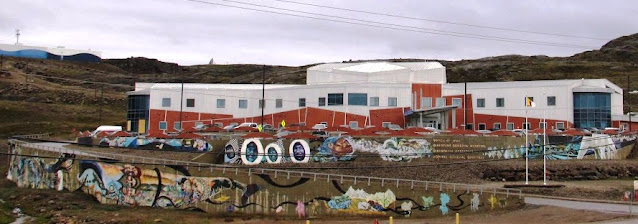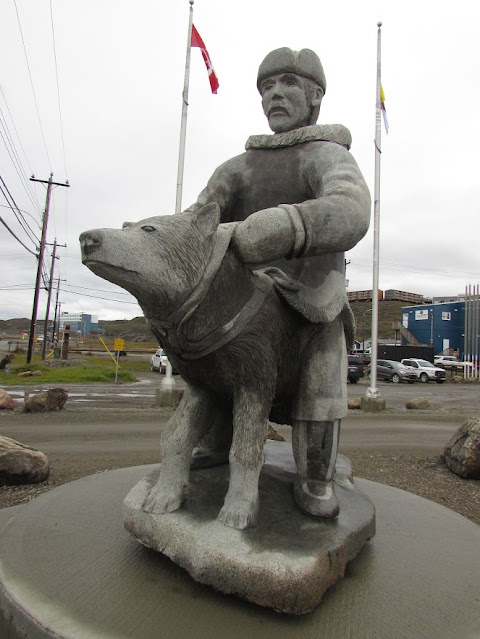We landed in the colourfully decorated airport of Iqaluit, the capital city of Nunavut, located a mere three degrees south of the Arctic Circle on Baffin Island, after a wonderful flight on the friendliest and only full service airline still operating in North America, Inuit owned Canadian North. Nunavut is Canada's newest and largest Territory, created out of the Northwest Territories in 1999 as part of a decades long land claims negotiation, and it's a self-governing territory for the 40,000 Inuit scattered across 25 isolated communities in the far north. The first thing you notice as you disembark (other than the cool air) is that all the buildings are brightly painted in a wide variety of colours.




Then, as you walk around and start looking a little closer, you notice how the buildings are all anchored to the exposed rock of the Canadian Shield, while underneath runs all the inter-connected piping that leads out to a sewage treatment plant on the edge of town. There are also many examples of imaginative architecture on display with all sorts of curiously shaped buildings including the igloo shaped St. Jude's Anglican Cathedral, the hospital with its colourful wraparound mural, the triangular RCMP building, and the children's schools that look like ice cubes.
St. Jude's Cathedral
Legislative Building
R.C.M.P Building
Aquatic Centre
General Hospital
Court of Justice
Inuit Broadcasting Corporation
Elementary School
High School
First stop to get properly acquainted with the city's attractions is the Unikkaarvik Visitor Centre that not only provides a great walking map but also features an informative exhibit of the territory and an Inuit drum dancer sculpture that is tailor made for selfies.
Unikkaarvik Visitor Centre
Next door is the Nunatta Sunakkutaangit Museum which also features many cultural artifacts, local artwork, and Nunuvut history housed within a former HBC building.
Nunatta Sunakkutaangit Museum
Unfortunately underneath all the colour of Iqaluit there is a darker side filled with the squalor of overcrowded and poorly ventilated housing, broken down vehicles and equipment, abandoned toys, and trash that speaks to the poverty, alcoholism and drug abuse that is rampant in the Inuit community. Some of this is due to a lack of employment opportunties (85% of the Nunavut population is Inuit but they make up only 40% of the government workforce) but it also reflects a reluctance to participate in the labour force for either cultural reasons or lack of education and training. While things are slowly improving only 50% of Inuit students graduate from high school.

High above the treeline and scoured by glaciers, the most prominant feature of Iqaluit itself and Nunavut in general is the rocks and boulders that are everywhere you look. Used as landmarks and/or boundary markers they are also a source of creativity and have been turned into some of the most amazing sculptures. In particular there is the stunning 20th anniversary monument of the Nunavut land claims agreements.


There is the man and his dog outside the RCMP headquarters.
A row of Inukshuks outside the Arctic college.
Arctic College

The entrance to the Legislative Assembly, which also showcases a beautiful mace made of narwhal and precious stones amongst the paintings and other beautifully crafted objects in the lobby.
Perhaps the most intriguing is the post office rock garden of fascinating sculptures.
But if you really wanted to get your rocks off you had to head out into the "country-side" where you could do a little hiking and take in some very unique views. So after settling into our hotel, we headed off on our first hike called the Apex Trail which starts at the graveyard and goes along the shores of Koojesse Inlet to Apex Beach.
And while there are plenty of rocks there's also a colourful ground cover of moss, flowers, shrubs, and berries that brighten the path.
At the end of the trail are the remains of the HBC post that had been moved here in 1949 to take advantage of the rapidly increasing population that arrived for the construction of the Distant Early Warning (DEW) line being built by the Americans.
After all that walking the first thing a person needs is a good brew pub and guess what, Iqaluit has the only one in all of Nunavut, and it's called NuBrew. A delightful place with 10 different brews on tap that's understandibly very popular with the locals and our go-to place for happy hour every day. Except for the restaurants, the only other place to purchase alcohol is the liquor store (one of only two in all of Nunavut the other one in Rankin Inlet which is 1,200 km away as the crow flies) and you have to register an account, and abide by the daily limit.

There were also great places to eat like the Black Heart Cafe or Snack for breakfast and the Frob Kitchen & Eatery or Storehouse Bar & Grill for dinner.
Iqaluit also boasts a beautiful Aquatic Centre and Fitness Centre with a 25 metre pool and a two storey water slide.
And speaking of water, the tidal changes in Iqaluit, at between 7 - 11 metres twice a day, are some of the largest in the world and, besides leaving the resident's boats high and dry, makes for some very accessible beachcombing.
Of course no visit to the North would be complete without taking home a beautiful Inuit carving of your favourite animal or mythological creature. Famed for their work in soapstone, serpentine, and marine ivory, Inuit artists have created a unique art form that traces its trading history back for hundreds of years.
But by far the most impressive place to go walkabout in Iqaluit is the Sylvia Grinnell Park located on the outskirts of town. Referred to as Iqaluit Kuunga in the Inuktitut language, Iqaluit means place of many fish and this refers to the Arctic char that live in the Sylvia Grinnell River that flows through the park. The park itself is spread out over 148 hectares and offers many places to view the river's waterfalls where locals can be seen fishing for the Arctic char, a member of the salmonidae family.








While the park is rocky and windswept it has its own beauty with soft ground that is filled with mosses and flowers to cushion your feet and cranberries and blueberries to nibble on as you walk along and keep an eye out for foxes, hares, caribou and even polar bears which are known to occasionally frequent the place. However the only animal we came across was a very friendly husky.
Iqaluit may be the largest community in Nunavut (8,500) but it shares one thing in common with all the others which is there's no road connecting it to any other town or hamlet in the territory. Each community is accessible only by plane or ship and to emphasize this is the Road To Nowhere sign on the edge of town.
The snow hadn't fallen yet so hitching a ride on a sleigh wasn't an option either though there were plenty of them lying around all over town. We were visiting in the hottest time of year with the temperature between 3 - 10 degrees Celsius (in winter it's between minus 20 and minus 30 Celsius).
Actually the main method for getting around town is by taxi and one of the most curious aspects of Iqaluit is that all of its taxi drivers are from various countries in Africa. Coming from the warmest part of the Earth to the coldest is a head shaker but speaks to the opportunities Canada has to offer even in the far North. There is also a large Filipino community living and working in Iqaluit.
Even though we were up in Canada's north and far away from any major city, it was still 2,917 km to the North Pole according to the sign posted in downtown Iqaluit and another indication of how vast the Arctic really is. It's going to take more than one trip to appreciate what Nunavut has to offer but, in the meantime, we were more than satisfied with our first visit.


























































































Very informative brother I liked the size of the burger June was attempting to eat lol . Looks like you were dressed appropriately for the weather.
ReplyDeleteMight have to make a trip up there
Thanks for sharing this inside sneak peek of Iqaluit! Glenda
ReplyDelete